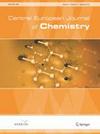The exploration of interaction studies of smaller size, mostly ignored yet intrinsically inestimable molecules towards BSA; An example of STD and DOSY NMR
引用次数: 15
Abstract
AbstractLarger size or novel structure molecules are always appreciated by all fields of experimental and computational science. Conversely, molecules with smaller size and simple structures are usually ignored with no explanation as to why. However, the vast majority of more diminutive molecules behave as a cornerstone in the synthesis of a bigger structural framework. Subsequently, we planned to uncover the interactions of small molecules towards macromolecules, and successfully presented the binding results of 2-aminopyridine and Isovanillin towards BSA through NMR techniques. STD epitope mapping and also the DOSY results provided evidence that Isovanillin remained closer to the binding cavity of protein. Titration experiments afforded 584 µM (0.584mM) and 487 µM (0.487 mM) dissociation constants for isovanillin and 2-aminopyridine respectively. Furthermore, changes in diffusion coefficient (with and without protein addition in DOSY spectra) were found to be 0.081 log (m2 s−1) and 0.096 log (m2 s−1) points for isovanillin and 2-aminopyridine respectively. Docking studies exhibit that these molecules can tie to site 1 (sub-area IIA) through the pi-pi interaction and hydrogen bonding with Trp213. Our results demonstrated that both compounds could be utilized as part of a transporter in the circulatory system and their extension-inspired compounds may be utilized in new drug design.探索小尺寸的相互作用研究,大多被忽视,但本质上不可估量的分子对BSA;STD和DOSY NMR的一个例子
摘要大尺寸或结构新颖的分子一直受到实验和计算科学各个领域的青睐。相反,那些体积更小、结构更简单的分子通常被忽略,也没有任何解释。然而,绝大多数更小的分子在合成更大的结构框架中起着基石的作用。随后,我们计划揭示小分子与大分子的相互作用,并通过NMR技术成功地展示了2-氨基吡啶和异香兰素与BSA的结合结果。STD表位定位和DOSY结果证明异香兰素更接近蛋白质的结合腔。滴定实验得到异香兰素和2-氨基吡啶的解离常数分别为584µM (0.584mM)和487µM (0.487 mM)。此外,对异香兰素和2-氨基吡啶的扩散系数变化(在DOSY光谱中加入和不加入蛋白质)分别为0.081 log (m2 s−1)和0.096 log (m2 s−1)点。对接研究表明,这些分子可以通过pi-pi相互作用和与Trp213的氢键结合到1号位点(子区域IIA)。我们的研究结果表明,这两种化合物都可以作为循环系统转运体的一部分,它们的延伸激发化合物可能用于新药设计。
本文章由计算机程序翻译,如有差异,请以英文原文为准。
求助全文
约1分钟内获得全文
求助全文

 求助内容:
求助内容: 应助结果提醒方式:
应助结果提醒方式:


